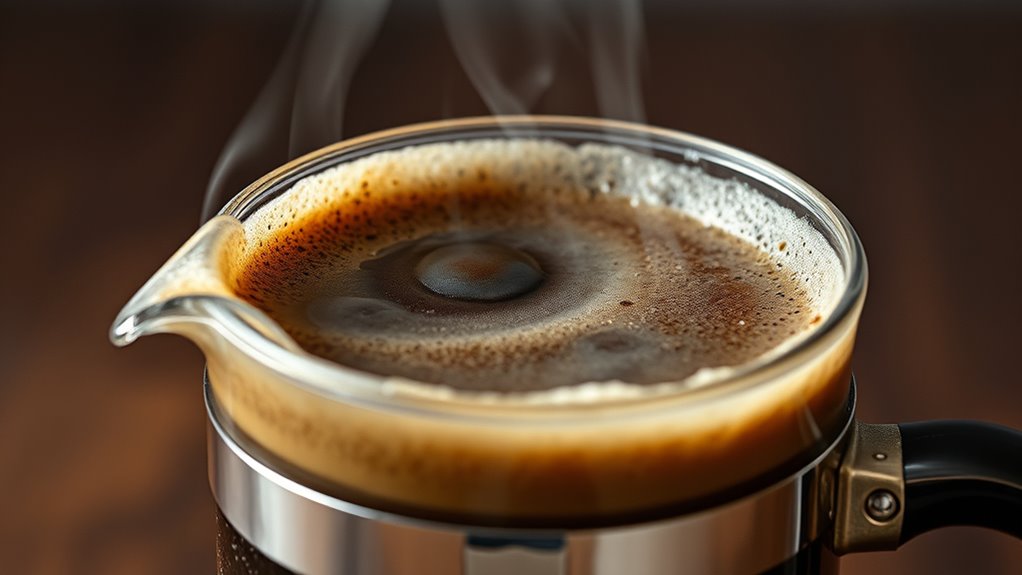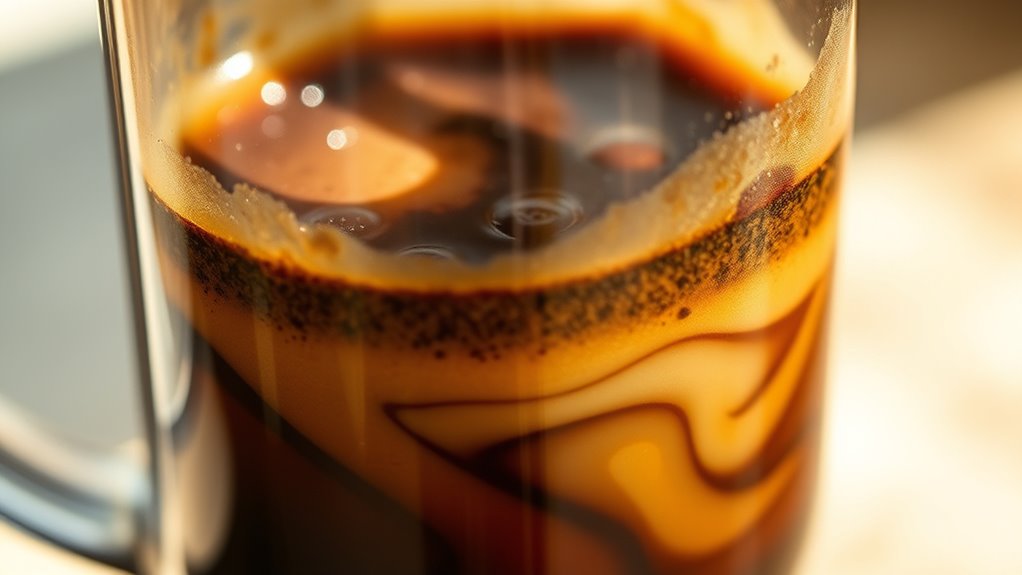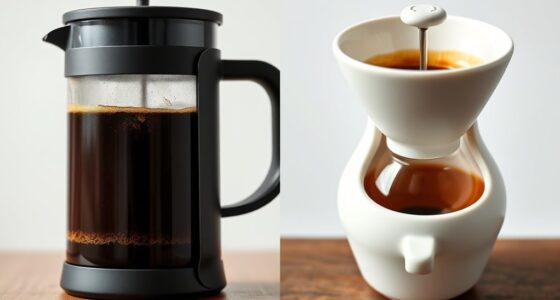To fix bitterness and muddy cups in your French press, start by adjusting your grind size to resemble coarse sea salt—finer grounds cause over-extraction and bitter flavors. Make certain your brew time is about 4 minutes; longer steeping can intensify muddiness. Use proper filtration and avoid rushing the process to reduce grit and sediment. Small tweaks in grind size and brew duration make a big difference. Keep refining your technique for a clean, flavorful cup as you explore more tips below.
Key Takeaways
- Use a coarse grind size resembling coarse sea salt to prevent over-extraction and muddy texture.
- Brew for around 4 minutes to balance flavor and avoid bitterness from over-steeping.
- Ensure proper filtration and avoid overly fine grounds to reduce grit and sediment in the cup.
- Adjust grind size or brew time if coffee tastes bitter or weak, through small, incremental changes.
- Maintain consistency and patience, tasting and refining your process for a cleaner, well-extracted cup.

Have you ever brewed a French press coffee only to find it weak, bitter, or overly gritty? If so, you’re not alone. Many coffee lovers face these issues, often stemming from simple mistakes like incorrect brew time or grind size. Understanding how these factors influence your brew can help you craft a smoother, more balanced cup every time.
First, let’s talk about grind size. If your coffee grounds are too fine, you’ll likely end up with a muddy, overly gritty cup. Finer grounds tend to extract more quickly and intensely, which can lead to bitterness and a sludgy texture at the bottom of your mug. On the other hand, if your grind is too coarse, the water passes through too quickly, resulting in a weak, under-extracted brew that lacks flavor and body. To avoid these pitfalls, aim for a consistency similar to coarse sea salt. This size allows for proper extraction without overdoing it, giving you a richer, more balanced taste.
Use a coarse, sea salt-sized grind for balanced, flavorful French press coffee.
Brew time is another critical factor. If you steep your coffee for too long, the extraction continues, pulling out bitter compounds that spoil the flavor. Typically, a brew time of around four minutes strikes the right balance—long enough to develop full flavor but short enough to prevent bitterness. If you find your coffee turns bitter, try reducing the steeping time slightly. Conversely, if your coffee feels weak or insipid, extend the brew time by half a minute to allow more flavor to develop. Remember, consistency is key—using the same brew time each time helps you dial in your perfect cup.
Temperature also plays a role, but focusing on grind size and brew time can markedly improve your results. Avoid rushing the process or using overly fine grounds. Instead, start with a coarse grind and a four-minute steep, then taste and adjust as needed. If your coffee still tastes bitter, check your grind size first—perhaps it’s too fine—and tweak accordingly. If it’s too weak, give the grounds a finer grind or extend the brew time slightly. Additionally, using proper filtration can help you achieve a clearer, cleaner cup by minimizing grit and sediment.
In the end, mastering the right grind size and brew time will help eliminate bitterness and muddy textures, leading to a clean, flavorful cup. Consistency and small adjustments based on taste are your best tools. With patience and attention to these details, you’ll soon brew French press coffee that’s perfectly balanced—rich, smooth, and free of grit or bitterness.
Frequently Asked Questions
Can Water Temperature Affect French Press Bitterness?
Yes, water temperature influences French press bitterness. If your water’s too hot, it extracts too many bitter compounds from the coffee grounds, especially when using poor water quality. Make sure to heat water to around 195-205°F before pouring it into your brewing vessel. Proper water temperature ensures a balanced extraction, avoiding harsh or muddy flavors, and enhances the overall quality of your coffee.
How Does Grind Size Impact Muddy Coffee?
You can prevent muddy coffee by paying attention to grind size and consistency. Using a too-coarse grind causes uneven particle extraction, leaving behind fine particles that make your brew cloudy. On the other hand, inconsistent grind sizes lead to over-extraction of some particles and under-extraction of others, resulting in a muddy, murky cup. Aim for uniform grind size for better particle extraction and a clearer, cleaner French press coffee.
What Type of Coffee Beans Prevent Bitterness?
To prevent bitterness, choose beans with a lighter roast level, as darker roasts tend to be more bitter. Opt for beans from regions like Central America or East Africa, where the bean origin offers brighter, fruitier flavors that balance bitterness. Stay away from over-roasted beans and those with a high oil content. Fresh, properly stored beans also help keep bitterness at bay, ensuring a smoother, more enjoyable cup.
Does Brewing Time Influence the Muddiness of the Brew?
Brewing time is like a delicate dance where flavor extraction guides your steps. If you extend brewing time too long, it can stir up muddiness, making your cup cloudy and less refined. Shorter brewing times might under-extract, leaving your coffee weak. To avoid muddiness, find that sweet spot where extraction is complete without overdoing it. Your perfect brew balances brewing time to reveal clear, vibrant flavors.
Are There Cleaning Tips to Improve French Press Flavor?
To improve your French press flavor, stick to regular cleaning routines. Rinse all parts thoroughly after each use and occasionally soak the plunger and beaker in vinegar or a coffee maker cleaner to eliminate built-up oils and residue. Using fresh coffee beans also makes a big difference. Proper cleaning guarantees oils and old coffee don’t taint your brew, helping you enjoy richer, cleaner flavors every time.
Conclusion
So, don’t despair if your French press feels frustrating. With a little patience, practice, and the right tweaks—like tweaking grind size, timing, and tamping—you’ll turn bitter brews into beautiful, balanced cups. Remember, troubleshooting takes time, but the triumph of a tasty, muddy-free mug makes it totally worth it. Keep experimenting, stay persistent, and soon you’ll savor sensational sips every single time. Cheers to conquering your coffee conundrums!









